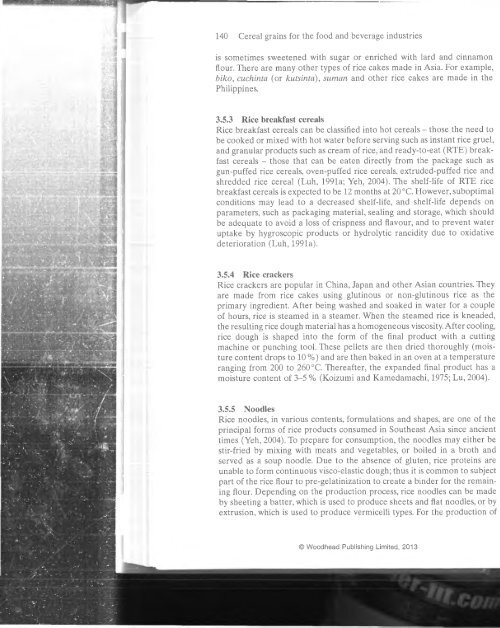Arendt und Zannini - 2013 - Cereal grains for the food and beverage industries
Arendt und Zannini - 2013 - Cereal grains for the food and beverage industries
Arendt und Zannini - 2013 - Cereal grains for the food and beverage industries
You also want an ePaper? Increase the reach of your titles
YUMPU automatically turns print PDFs into web optimized ePapers that Google loves.
140 <strong>Cereal</strong> <strong>grains</strong> <strong>for</strong> <strong>the</strong> <strong>food</strong> <strong>and</strong> <strong>beverage</strong> <strong>industries</strong><br />
is sometimes sweetened with sugar or enriched with lard <strong>and</strong> cinnamon<br />
flour. There are many o<strong>the</strong>r types of rice cakes made in Asia. For example,<br />
biko, cuchinta (or kutsinta), suman <strong>and</strong> o<strong>the</strong>r rice cakes are made in <strong>the</strong><br />
Philippines.<br />
3.5.3 Rice breakfast cereals<br />
Rice breakfast cereals can be classified into hot cereals - those <strong>the</strong> need to<br />
be cooked or mixed with hot water be<strong>for</strong>e serving such as instant rice gruel,<br />
<strong>and</strong> granular products such as cream of rice, <strong>and</strong> ready-to-eat (RTF) breakfast<br />
cereals - those that can be eaten directly from <strong>the</strong> package such as<br />
gun-puffed rice cereals, oven-puffed rice cereals, extruded-puffed rice <strong>and</strong><br />
shredded rice cereal (Luh, 1991a; Yeh, 2004). The shelf-life of RTE rice<br />
breakfast cereals is expected to be 12 months at 20 °C. However, suboptimal<br />
conditions may lead to a decreased shelf-life, <strong>and</strong> shelf-life depends on<br />
parameters, such as packaging material, sealing <strong>and</strong> storage, which should<br />
be adequate to avoid a loss of crispness <strong>and</strong> flavour, <strong>and</strong> to prevent water<br />
uptake by hygroscopic products or hydrolytic rancidity due to oxidative<br />
deterioration (Luh, 1991a).<br />
3.5.4 Rice crackers<br />
Rice crackers are popular in China, Japan <strong>and</strong> o<strong>the</strong>r Asian countries. They<br />
are made from rice cakes using glutinous or non-glutinous rice as <strong>the</strong><br />
primary ingredient. After being washed <strong>and</strong> soaked in water <strong>for</strong> a couple<br />
of hours, rice is steamed in a steamer. When <strong>the</strong> steamed rice is kneaded,<br />
<strong>the</strong> resulting rice dough material has a homogeneous viscosity. After cooling,<br />
rice dough is shaped into <strong>the</strong> <strong>for</strong>m of <strong>the</strong> final product with a cutting<br />
machine or punching tool. These pellets are <strong>the</strong>n dried thoroughly (moisture<br />
content drops to 10 %) <strong>and</strong> are <strong>the</strong>n baked in an oven at a temperature<br />
ranging from 200 to 260 °C. Thereafter, <strong>the</strong> exp<strong>and</strong>ed final product has a<br />
moisture content of 3-5 % (Koizumi <strong>and</strong> Kamedamachi, 1975; Lu, 2004).<br />
3.5,5 Noodles<br />
Rice noodles, in various contents, <strong>for</strong>mulations <strong>and</strong> shapes, are one of <strong>the</strong><br />
principal <strong>for</strong>ms of rice products consumed in Sou<strong>the</strong>ast Asia since ancient<br />
times (Yeh, 2004). To prepare <strong>for</strong> consumption, <strong>the</strong> noodles may ei<strong>the</strong>r be<br />
stir-fried by mixing with meats <strong>and</strong> vegetables, or boiled in a broth <strong>and</strong><br />
served as a soup noodle. Due to <strong>the</strong> absence of gluten, rice proteins are<br />
unable to <strong>for</strong>m continuous visco-elastic dough; thus it is common to subject<br />
part of <strong>the</strong> rice flour to pre-gelatinization to create a binder <strong>for</strong> <strong>the</strong> remaining<br />
flour. Depending on <strong>the</strong> production process, rice noodles can be made<br />
by sheeting a batter, which is used to produce sheets <strong>and</strong> flat noodles, or by<br />
extrusion, which is used to produce vermicelli types. For <strong>the</strong> production of<br />
© Woodhead Publishing Limited, <strong>2013</strong>

















